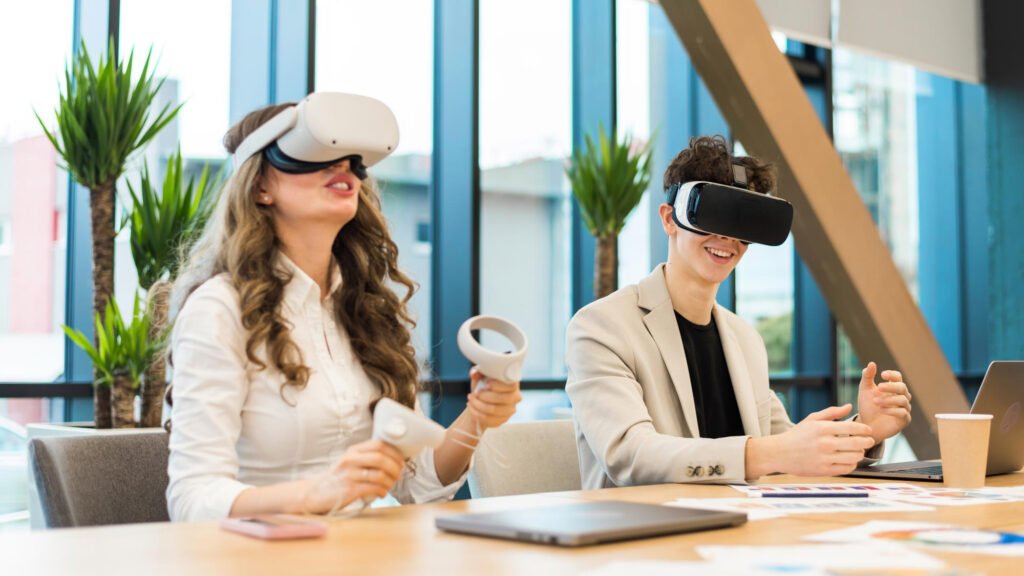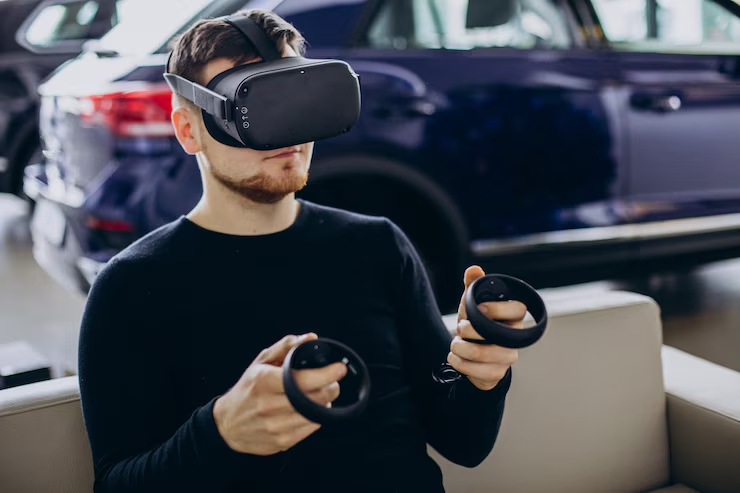Introduction to VR in B2B Sales
Virtual Reality (VR) is emerging as a transformative technology in the Business-to-Business (B2B) sales landscape. By creating immersive, interactive environments, VR offers organizations innovative ways to engage with potential clients. Unlike traditional sales methods, which often rely on in-person meetings or static presentations, VR can simulate real-world scenarios where customers can experience products and services in a virtual setting. This immersive approach allows for a deeper understanding of offerings, ultimately enhancing customer engagement and fostering meaningful connections.
As businesses face an increasingly competitive market, the adoption of VR technology is becoming essential for effective sales strategies. Companies leverage VR for product demonstrations, training, and sales pitches, offering an experience that transcends ordinary sales techniques. The unique capability of VR to visualize complex solutions or intricate products enables clients to grasp value propositions quickly and efficiently, thereby facilitating informed decision-making.
Moreover, the integration of VR into B2B sales not only streamlines the selling process but also expands the reach of sales teams. With the ability to engage potential customers remotely, businesses can effectively operate across geographical boundaries. This is particularly beneficial for companies with a global presence, as VR allows them to present their offerings as if they were in the same room with prospective clients, ensuring that distance is no longer a barrier to successful negotiations.
The significance of VR in enhancing the B2B sales process is evident as it helps in creating memorable experiences that can lead to increased conversion rates and customer loyalty. As VR technology continues to evolve, its influence on sales growth across various industries is likely to become even more pronounced, setting a new standard in the way businesses connect, communicate, and thrive within the B2B sector.
Understanding B2B Sales Growth
B2B sales growth refers to the increase in revenue generated from transactions between businesses, as opposed to consumer sales. This growth is influenced by several key factors, including effective marketing strategies, robust relationship management, and the continuous evolution of technology. A successful B2B sales strategy necessitates a comprehensive understanding of the target market along with the ability to address clients’ needs through tailored offerings.
One of the traditional sales strategies employed in driving B2B sales growth involves relationship building. Establishing strong connections with potential clients is crucial; however, this often translates into significant time and resources being allocated to nurturing these relationships. Sales representatives traditionally prioritize face-to-face interactions, which, while valuable, can limit the reach and scalability of a sales approach. As businesses grow and diversify their clientele, the complexities of managing relationships across various sectors can present substantial challenges.
Moreover, the rapid pace of technological advancement presents an additional layer of difficulty. Companies now must adapt to evolving buyer preferences and purchasing behaviors, driven largely by the increasing prevalence of digital solutions. Traditional methods such as cold calling or direct mail have been supplemented, and in many cases replaced, by digital marketing strategies and social selling techniques. The modern B2B buyer typically conducts extensive research and comparison before making purchasing decisions, establishing the necessity for companies to be accessible and informative throughout the buyer’s journey.
Furthermore, competition in the B2B landscape is intense, necessitating differentiation and value propositions that resonate with target customers. As firms navigate these challenges, there is a growing need for innovative solutions that enhance engagement and drive sales growth. It is here that technologies such as virtual reality (VR) are stepping in, revolutionizing B2B interactions by providing immersive experiences that can lead to better-informed decisions and stronger connections between businesses.
How VR Enhances Product Demonstrations
Virtual reality (VR) technology is fundamentally altering the landscape of B2B sales by transforming how product demonstrations are conducted. Traditionally, sales teams relied on static presentations, physical prototypes, or video displays to convey product features and benefits. However, through immersive experiences, VR enables potential clients to engage with products in an interactive and meaningful manner. This shift enhances understanding and connection between buyers and products, ultimately leading to more informed purchasing decisions.
Industries such as manufacturing, real estate, and healthcare have begun leveraging VR to create captivating product demonstrations. For instance, in the manufacturing sector, companies can utilize VR to simulate complex machinery, allowing prospective buyers to explore operations, configurations, and functionalities without needing physical models. This not only showcases the product effectively but also alleviates logistical challenges often associated with physical demonstrations.
Moreover, real estate agents are using VR to create virtual walkthroughs of properties, providing potential buyers with a firsthand experience without the need for physical visits. This instantaneous, immersive experience allows clients to visualize spaces, aiding their decision-making process and enhancing the likelihood of closing deals. Furthermore, in healthcare, VR demonstrates surgical tools or new medical equipment, providing medical professionals with the hands-on experience necessary to understand the product’s capabilities and benefits.
These enhanced demonstrations foster higher engagement levels from potential clients. When customers can experience a product in a realistic environment, they develop a deeper connection, which can lead to increased trust and willingness to invest. Statistical data has shown that companies adopting VR for product demonstrations see significant uplift in conversion rates. By effectively using VR technologies, businesses not only distinguish themselves in a competitive marketplace but also cultivate more significant sales growth through innovative presentation methods.
Improved Customer Experience with VR
The advent of Virtual Reality (VR) technology has significantly transformed the landscape of B2B sales growth by enhancing customer experience throughout various touchpoints. One of the most notable innovations in this space is the introduction of virtual showrooms. These immersive environments allow potential buyers to explore products in a lifelike setting, bridging the gap between physical and digital interactions. Virtual showrooms provide users with a 360-degree view of products, enabling them to engage with items as they might in a brick-and-mortar environment. This sensory experience can lead to a more informed decision-making process, as customers can visualize how products will fit into their operations.
Furthermore, VR fosters more engaging and personalized customer interactions. Sales representatives can utilize VR tools to guide clients through product demonstrations in real time, tailoring their approach to align with the specific needs and preferences of each customer. This level of interactivity not only makes the experience more enjoyable but also encourages a deeper understanding of the product offerings. By enhancing the engagement factor, businesses can cultivate stronger relationships with their clients, ultimately leading to increased customer loyalty.
Another critical aspect of improving customer experience with VR is the ability to visualize products in their intended environments. Whether it is machinery on a factory floor or software applications on a business workstation, customers can see how products will function within their specific context. This capability alleviates uncertainties that often plague B2B buyers, as they can assess functionality and fit more accurately. By meeting customer needs through innovative visualization techniques, businesses can enhance satisfaction, which is vital for nurturing long-term partnerships. In an era where customer experience plays a pivotal role in business success, the integration of VR in B2B sales strategies stands out as a transformative trend worth embracing.
Cost-Effectiveness of VR Solutions
The integration of virtual reality (VR) technology into B2B sales strategies presents a compelling case for cost-effectiveness, especially when examining the long-term financial benefits outweighing initial investment. Although the upfront costs for VR hardware and software can be significant, organizations increasingly find that these expenses are dwarfed by the savings realized over time. One primary avenue through which VR contributes to cost reduction is by minimizing travel expenses. Traditional sales processes often require sales teams to travel extensively to meet clients, conduct presentations, and facilitate product demonstrations. In contrast, VR enables comprehensive, immersive experiences remotely, significantly reducing the need for business trips and associated costs.
Furthermore, VR can lead to a decrease in product returns, a significant cost burden for many B2B companies. By utilizing virtual prototypes and immersive demonstrations, buyers gain a clearer understanding of products before making a purchase. This enhanced transparency can lead to more informed purchasing decisions, thus reducing the likelihood of returns driven by misaligned expectations. Moreover, VR provides the unique opportunity for stakeholders to engage with products in a simulated environment, further lowering return rates through greater satisfaction.
Studies have shown that businesses integrating VR into their sales strategies can experience remarkable improvement in conversion rates. By engaging potential clients through interactive experiences, organizations can enhance customer engagement, leading to higher sales opportunities. For example, a prominent tech company reported a 25% increase in conversion rates after implementing VR into their sales demonstrations, underscoring the substantial return on investment (ROI) achievable through this technology. Overall, the long-term gains from adopting VR solutions—ranging from reduced travel costs and lower product returns to increased conversion rates—illustrate a promising shift towards more efficient and effective B2B sales methodologies.

Training and Onboarding with VR
Virtual Reality (VR) is proving to be a transformative tool in the realm of training and onboarding for B2B sales teams. By immersing employees in simulated environments that mimic real-world scenarios, VR facilitates practical learning experiences that enhance skill acquisition. This innovative approach allows sales professionals to engage in hands-on practice without the risks associated with real-life sales situations.
One of the significant advantages of using VR for training is its ability to create highly realistic simulations. This technology can replicate various sales environments, from initial client meetings to product demonstrations, enabling sales teams to rehearse their interactions. By participating in these immersive simulations, employees can experience the nuances of customer engagement while refining their communication and negotiation techniques. This method not only accelerates the learning curve but also boosts confidence as employees become adept at handling diverse customer scenarios.
Furthermore, VR training programs can be customized to align with specific company objectives and sales strategies. This tailored approach ensures that employees are not only familiarized with their product offerings but also trained in effective sales tactics that resonate with their target market. By incorporating feedback mechanisms within the virtual environment, organizations can provide real-time assessments and guidance, facilitating continuous improvement among their sales personnel.
As the market becomes increasingly competitive, leveraging VR for training and onboarding is essential for cultivating a skilled sales force. The interactive nature of VR fosters deeper engagement and retention compared to traditional training methods. Consequently, companies that adopt VR technology for onboarding are likely to see substantial enhancements in their sales performance, creating a more adept and responsive sales team. This innovative approach underscores the pivotal role VR is playing in revolutionizing the B2B sales landscape.
Data-Driven Insights from VR Interactions
Virtual Reality (VR) has emerged as a transformative technology in the realm of B2B sales, offering not just immersive experiences but also invaluable data-driven insights. During customer interactions within VR environments, various metrics are generated that provide comprehensive information about buyer behavior and preferences. This capability enables businesses to better understand the efficacy of their sales strategies and the impact of their offerings on prospects.
Analytics tools associated with VR platforms play a critical role in assessing engagement metrics, such as time spent in a virtual environment, interaction levels with products, and even emotional responses captured through biometric data. These insights can reveal which aspects of a product or service are most appealing to buyers, allowing sales teams to tailor their pitches to align closely with customer interests. For example, if data shows that users engage more with certain features, companies can place greater emphasis on these attributes in their presentations.
Moreover, the ability to gather and analyze qualitative data is another significant advantage of using VR in B2B sales. Feedback can be collected in real-time as customers navigate through simulated experiences, providing immediate insights into areas for improvement. This instantaneous feedback mechanism not only aids in pinpointing customer preferences but also enhances the overall user experience by allowing companies to make iterative improvements swiftly.
By leveraging the data collected from VR interactions, businesses can refine their sales strategies further. Organizations can segment their target audience more effectively, adopt personalized approaches, and make informed decisions that lead to higher conversion rates. The integration of these data-driven insights into the sales process ultimately positions companies to foster stronger relationships with their clients and drive sustainable growth.
Challenges of Implementing VR in Sales
As Virtual Reality (VR) gains traction in B2B sales environments, organizations must navigate several challenges that may hinder successful implementation. One of the primary obstacles is the technological barrier, which encompasses both hardware and software requirements. Organizations must invest in high-quality VR equipment, including headsets and compatible systems, to ensure an immersive experience for their sales teams and clients. Additionally, the development of tailored VR applications or solutions that cater to specific sales processes can be resource-intensive, necessitating collaboration with experienced developers. The initial costs associated with procuring this technology, along with its maintenance, can pose a significant challenge, particularly for small to medium enterprises.
Resistance to change is another critical hurdle organizations encounter when adopting VR technologies in their sales processes. Sales teams may be accustomed to traditional methods, such as face-to-face meetings and presentations, and may feel overwhelmed by the prospect of incorporating a new medium into their practices. This reluctance can stem from uncertainties regarding the effectiveness of VR in demonstrating products and services or a lack of familiarity with the technology itself. To address this issue, organizations must cultivate a culture of openness to innovation, where team members are encouraged to embrace new tools as enhancements to their existing methodologies.
Furthermore, the need for ongoing support and training cannot be overstated. To ensure effective utilization of VR technology, organizations must develop structured training programs that educate sales teams on how to navigate and leverage VR solutions effectively. Continuous support from technical teams is also essential to troubleshoot any issues that may arise during usage. By addressing these challenges and fostering a supportive environment for VR integration, organizations can effectively harness the potential of this emerging technology, driving their B2B sales growth towards new horizons.
Future Trends: VR in B2B Sales
The future of virtual reality (VR) in B2B sales is poised for significant transformation, driven by continuous advancements in technology and changing market demands. As businesses increasingly recognize the value of VR, a multitude of trends is emerging that promises to revolutionize the way organizations approach sales and customer engagement. One of the most notable trends is the integration of artificial intelligence (AI) and machine learning into VR environments. This integration allows for enhanced data analytics and personalized customer experiences, ultimately leading to improved sales performance and stronger customer relationships.
Moreover, as VR technology becomes more accessible and cost-effective, small to medium-sized enterprises (SMEs) are likely to adopt these immersive solutions, further democratizing the benefits of VR in the B2B sales landscape. This broader adoption may lead to innovative use cases, such as virtual product demonstrations, where potential buyers can interact with 3D models of products in a virtual setting. Such capabilities not only facilitate a deeper understanding of the offerings but also create memorable experiences that can significantly influence purchasing decisions.
Another emerging trend is the augmented reality (AR) crossover with VR. The combination of both technologies can lead to hybrid solutions that provide enhanced interactive experiences. For instance, businesses can utilize AR to overlay digital information onto the physical world, allowing sellers to visualize data points or product features in real-time during sales presentations. This blend has the potential to make sales pitches more engaging and informative, thereby increasing conversion rates.
To remain competitive in an increasingly digital marketplace, businesses must adopt innovative solutions, including VR technologies. The potential of VR in B2B sales extends beyond mere visualization; it is about creating an immersive and interactive environment that fosters deeper engagement. As these trends unfold, organizations that proactively integrate VR into their sales strategies may achieve substantial competitive advantages.










